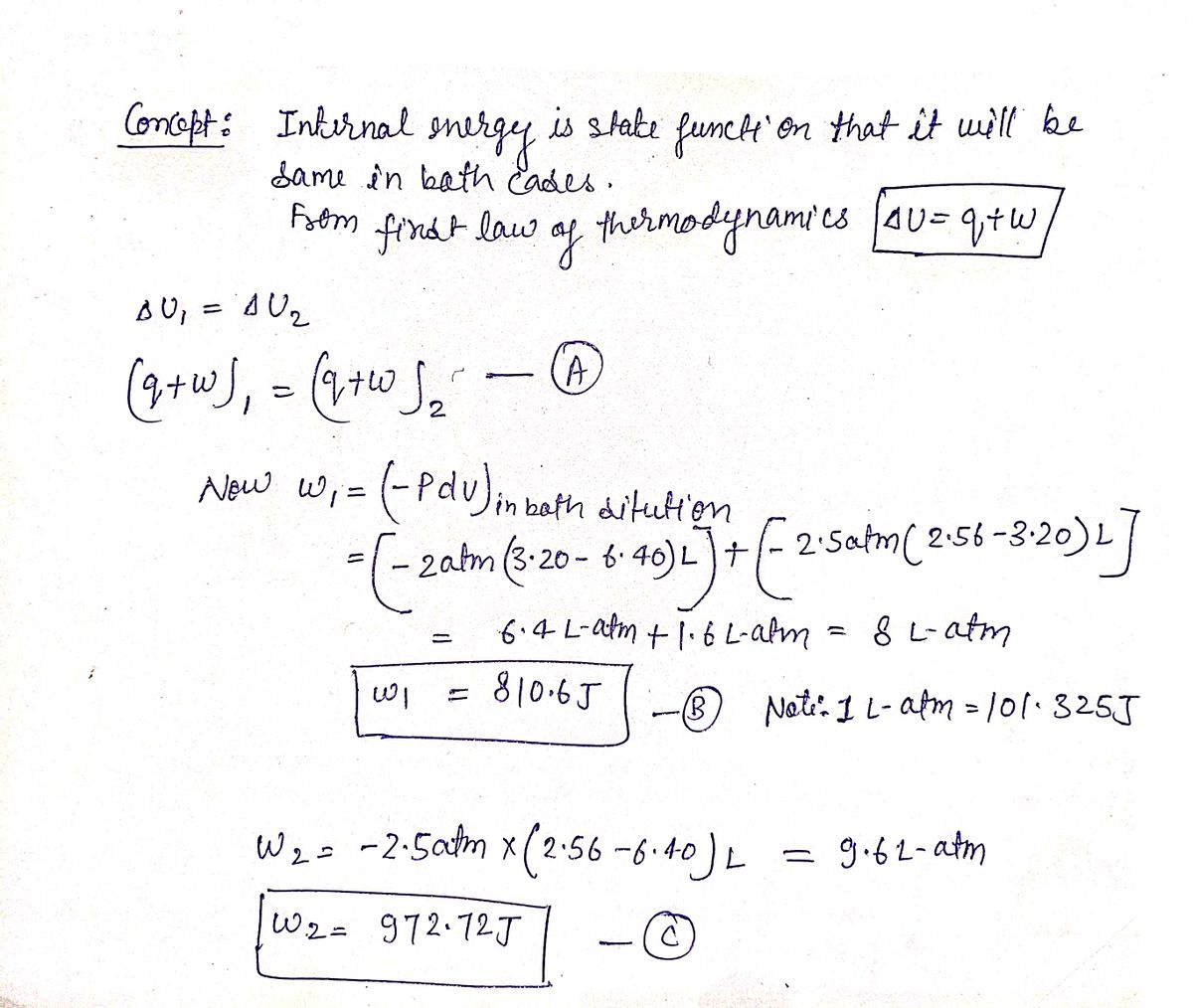lates of the system. Part C An ideal gas (which is is a hypothetical gas that conforms to the laws governing gas behavior) confined to a container with a massless piston at the top. (Figure 2) A massless wire is attached to the piston. When an external pressure of 2.00 atm is applied to the wire, the gas compresses from 6.40 to 3.20 L. When the external pressure is increased to 2.50 atm, the gas further compresses from 3.20 to 2,56 L In a separate experiment with the same initial conditions, a pressure of 2.50 atm was applied to the ideal gas, decreasing its volume from 6.40 to 2.56 L in one step. If the final temperature was the same for both processes, what is the difference between q for the two-step process and q for the one-step process in joules? Express your answer with the appropriate units. > View Available Hint(s) HA Value Units Submit
lates of the system. Part C An ideal gas (which is is a hypothetical gas that conforms to the laws governing gas behavior) confined to a container with a massless piston at the top. (Figure 2) A massless wire is attached to the piston. When an external pressure of 2.00 atm is applied to the wire, the gas compresses from 6.40 to 3.20 L. When the external pressure is increased to 2.50 atm, the gas further compresses from 3.20 to 2,56 L In a separate experiment with the same initial conditions, a pressure of 2.50 atm was applied to the ideal gas, decreasing its volume from 6.40 to 2.56 L in one step. If the final temperature was the same for both processes, what is the difference between q for the two-step process and q for the one-step process in joules? Express your answer with the appropriate units. > View Available Hint(s) HA Value Units Submit
Chemistry
10th Edition
ISBN:9781305957404
Author:Steven S. Zumdahl, Susan A. Zumdahl, Donald J. DeCoste
Publisher:Steven S. Zumdahl, Susan A. Zumdahl, Donald J. DeCoste
Chapter1: Chemical Foundations
Section: Chapter Questions
Problem 1RQ: Define and explain the differences between the following terms. a. law and theory b. theory and...
Related questions
Question

Transcribed Image Text:States of the system.
Part C
An ideal gas (which is is a hypothetical gas that conforms to the laws governing gas behavior) confined to a container with a massless piston at the top. (Figure 2) A
massless wire is attached to the piston. When an external pressure of 2.00 atm is applied to the wire, the gas compresses from 6.40 to 3.20 L. When the external
pressure is increased to 2.50 atm, the gas further compresses from 3.20 to 2.56 L
In a separate experiment with the same initial conditions, a pressure of 2.50 atm was applied to the ideal gas, decreasing its volume from 6.40 to 2.56 L in one step.
If the final temperature was the same for both processes, what is the difference between q for the two-step process and q for the one-step process in joules?
Express your answer with the appropriate units.
> View Available Hint(s)
HA
Value
Units
Submit
Expert Solution
Step 1

Trending now
This is a popular solution!
Step by step
Solved in 2 steps with 2 images

Knowledge Booster
Learn more about
Need a deep-dive on the concept behind this application? Look no further. Learn more about this topic, chemistry and related others by exploring similar questions and additional content below.Recommended textbooks for you

Chemistry
Chemistry
ISBN:
9781305957404
Author:
Steven S. Zumdahl, Susan A. Zumdahl, Donald J. DeCoste
Publisher:
Cengage Learning

Chemistry
Chemistry
ISBN:
9781259911156
Author:
Raymond Chang Dr., Jason Overby Professor
Publisher:
McGraw-Hill Education

Principles of Instrumental Analysis
Chemistry
ISBN:
9781305577213
Author:
Douglas A. Skoog, F. James Holler, Stanley R. Crouch
Publisher:
Cengage Learning

Chemistry
Chemistry
ISBN:
9781305957404
Author:
Steven S. Zumdahl, Susan A. Zumdahl, Donald J. DeCoste
Publisher:
Cengage Learning

Chemistry
Chemistry
ISBN:
9781259911156
Author:
Raymond Chang Dr., Jason Overby Professor
Publisher:
McGraw-Hill Education

Principles of Instrumental Analysis
Chemistry
ISBN:
9781305577213
Author:
Douglas A. Skoog, F. James Holler, Stanley R. Crouch
Publisher:
Cengage Learning

Organic Chemistry
Chemistry
ISBN:
9780078021558
Author:
Janice Gorzynski Smith Dr.
Publisher:
McGraw-Hill Education

Chemistry: Principles and Reactions
Chemistry
ISBN:
9781305079373
Author:
William L. Masterton, Cecile N. Hurley
Publisher:
Cengage Learning

Elementary Principles of Chemical Processes, Bind…
Chemistry
ISBN:
9781118431221
Author:
Richard M. Felder, Ronald W. Rousseau, Lisa G. Bullard
Publisher:
WILEY